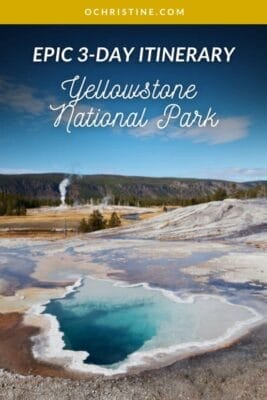This article’s recommendations may include affiliate links.
Looking for a new national park adventure? I’ve been to every US state and many of the national parks within them – including Yellowstone National Park. Yellowstone NP is such a vast wilderness (with a small window of warm weather to visit) that you really need to take extra time to plan effectively. That’s why I made this 3-day Yellowstone Itinerary and Travel Guide to help you.
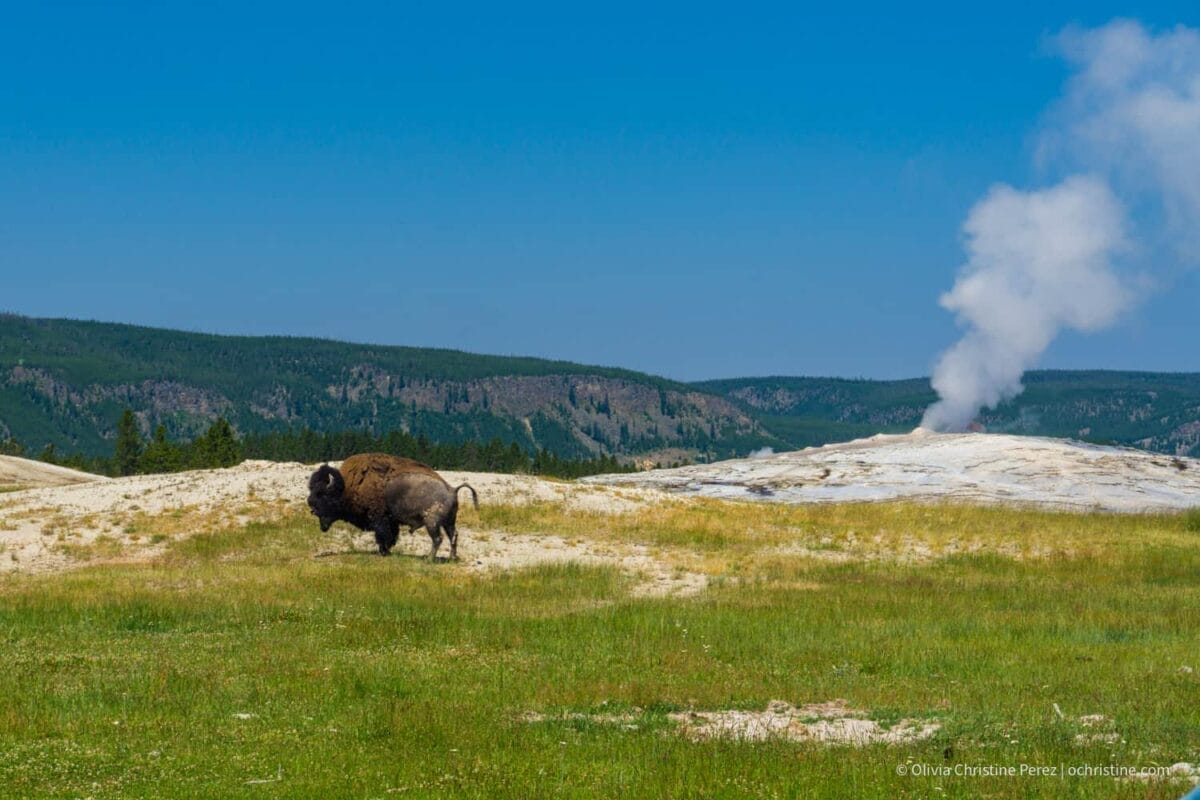

I visited Yellowstone National Park with my husband during summer season. We dedicated 3 full days to exploring Yellowstone, but this park spans multiple states so even that felt tight. After all, driving the loop alone is over 140 miles!
We explored geysers up-close, multicolored springs, and wide-open meadows. There were so many wildlife sightings and large tourist crowds yet, despite visiting during the busiest time of the year, we still found moments of calm and quiet.
About Yellowstone National Park
Yellowstone National Park attracts more than 4 million visitors each year because of its access to wildlife and outdoor landscape, and is the fourth most visited national park in the country.
It spans more than 2 million acres from the northwest of Wyoming into the edges of Montana and Idaho, and is the ancestral land of many Indigenous tribes, including the Blackfeet, Crow, and Shoshone. It has been – and is still – a religious, medicinal, and food resource for Natives.
After living on this land for thousands of years, these Indigenous tribes were either killed or displaced, moving them to reservations throughout the region outside of the park. The land was then set aside to preserve its terrain and hot water resource, establishing it as the country’s first national park in 1872. Today, there are some tribes that still have treaty rights to continue their traditions, like hunting/gathering and plant medicine, albeit restrictive.
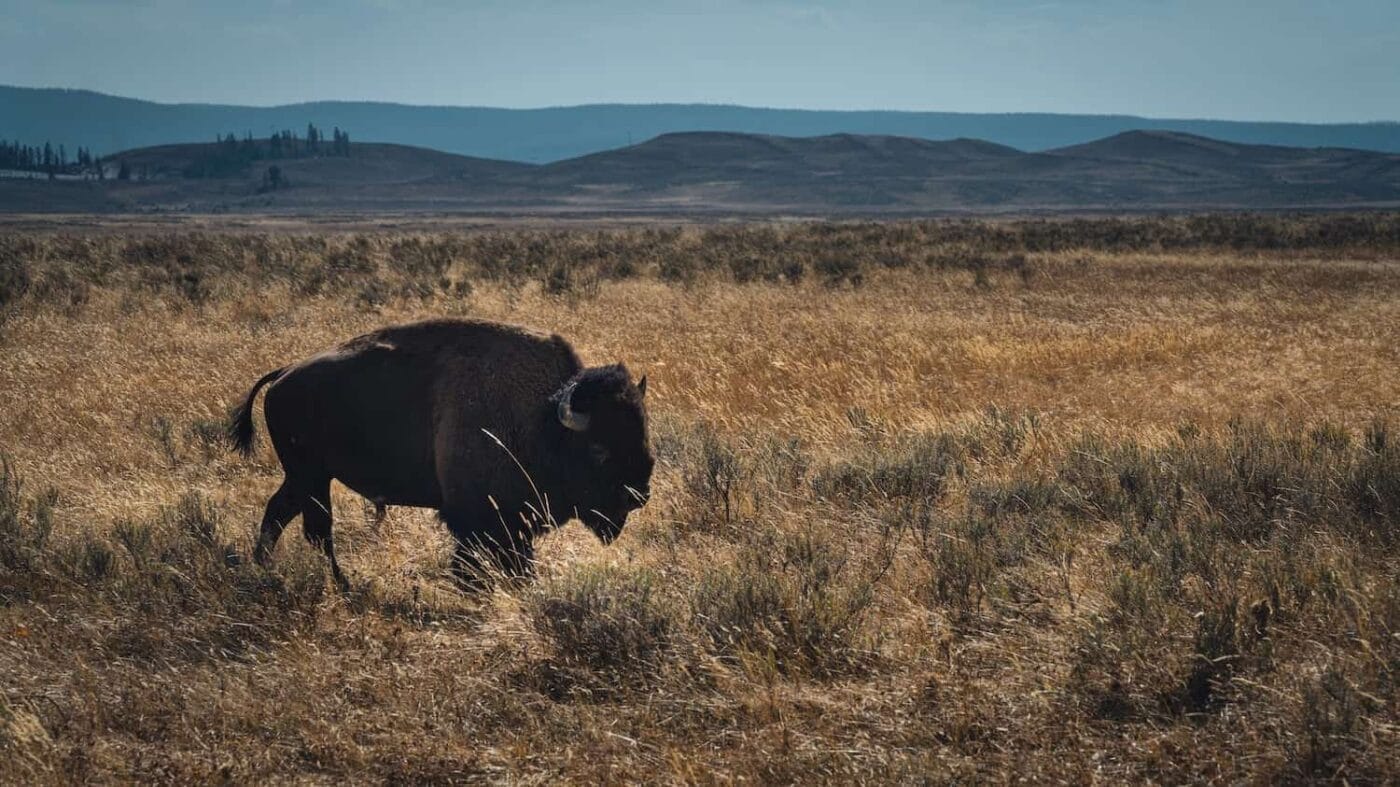

Park Costs & Best Time to Visit Yellowstone
How Much Does it Cost to Visit Yellowstone?
The cost of visiting Yellowstone National Park varies from $0-35 entry fee, with some caveats.
With an annual National Parks Pass or annual Yellowstone Pass ($70-80) you can get into Yellowstone for free. If you don’t have an annual pass, you can expect to pay $35 per vehicle, which is valid for seven days.
- NOTE: If you are entering the park from the South Entrance, you’ll have to come via Grand Teton National Park, which is a separate entry fee in addition to Yellowstone’s fee. I came in through the West Entrance from Montana.
When To Go to Yellowstone National Park
Even in the middle of the summer, nighttime temperatures in the park can drop into the 30s. I camped right outside of the park at a KOA campground and was shivering at night, wearing lots of layers.
Here are the best times to visit the park:
- High Season: June, July and August have warm weather, perfect for sleeping outside. Though the season is also crowded (due to summer break for schools), this is still one of the best national parks to visit in summer.
- Shoulder Season: find the tail end of fall foliage in September – early October or catch the beginning of snow melt in late April – May. There may be fewer road closures, fewer crowds, and milder weather.
- Low Season: Albeit too cold for me, winter is perfect if you want to avoid crowds and enjoy snowmobiling or cross-country skiing in the park. Do not camp.
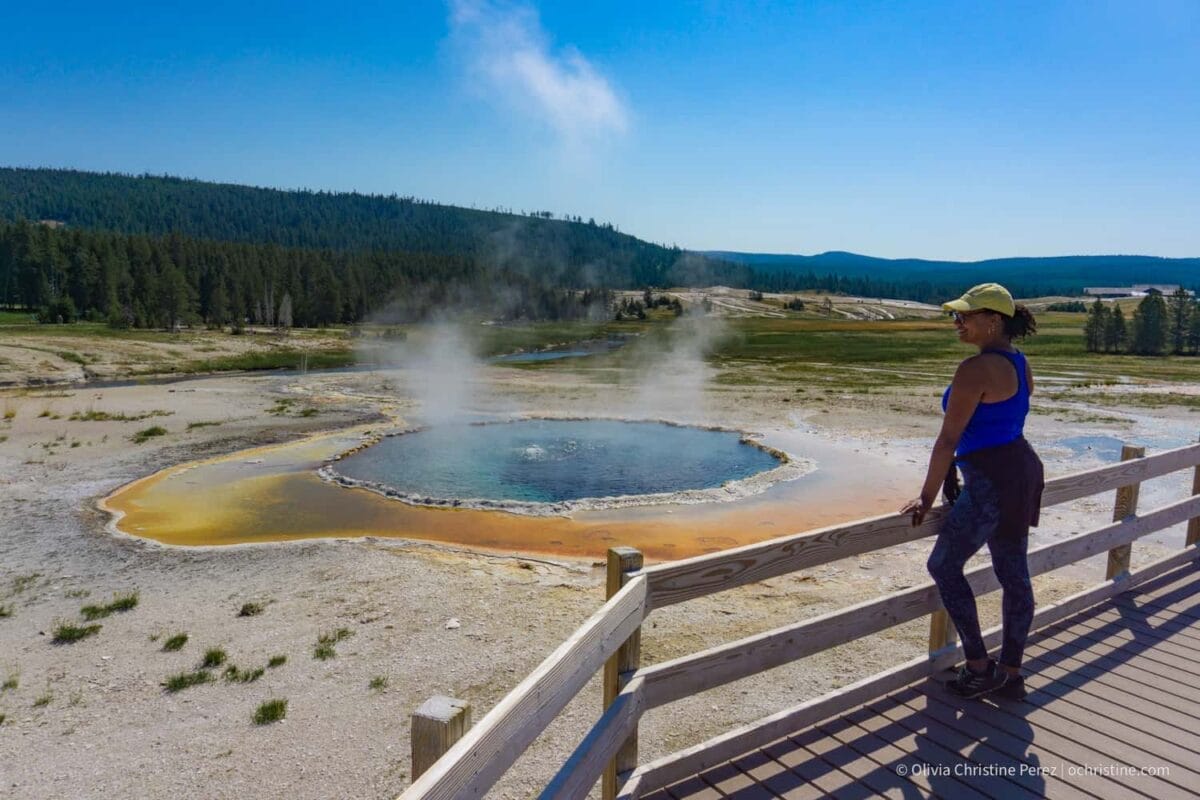

How To Get To Yellowstone National Park
While there’s no public transportation system in Yellowstone, there are many ways to get to the park.
How To Get To Yellowstone National Park by Car
A private car is the best mode of transport for visiting Yellowstone. You can bring your personal vehicle (we did, on a road trip) or rent cars at any nearby airports. Free parking is available but it can be challenging to find a spot during the peak season, so come early.
How To Get To Yellowstone National Park by Plane
The “Gateway to Yellowstone” is the Bozeman Yellowstone International Airport (BZN) in Montana. It’s the closest and most accessible airport to Yellowstone. Just a warning, it is also the busiest airport in Montana, so plan accordingly.
How To Get To Yellowstone National Park by Public Transit
Although no public transit is available, you may want to consider a guided van or bus tour of the park. This will help you avoid the challenge of finding parking and the process of renting a car. You can check the authorized Road-Based Tours within Yellowstone National Park here.
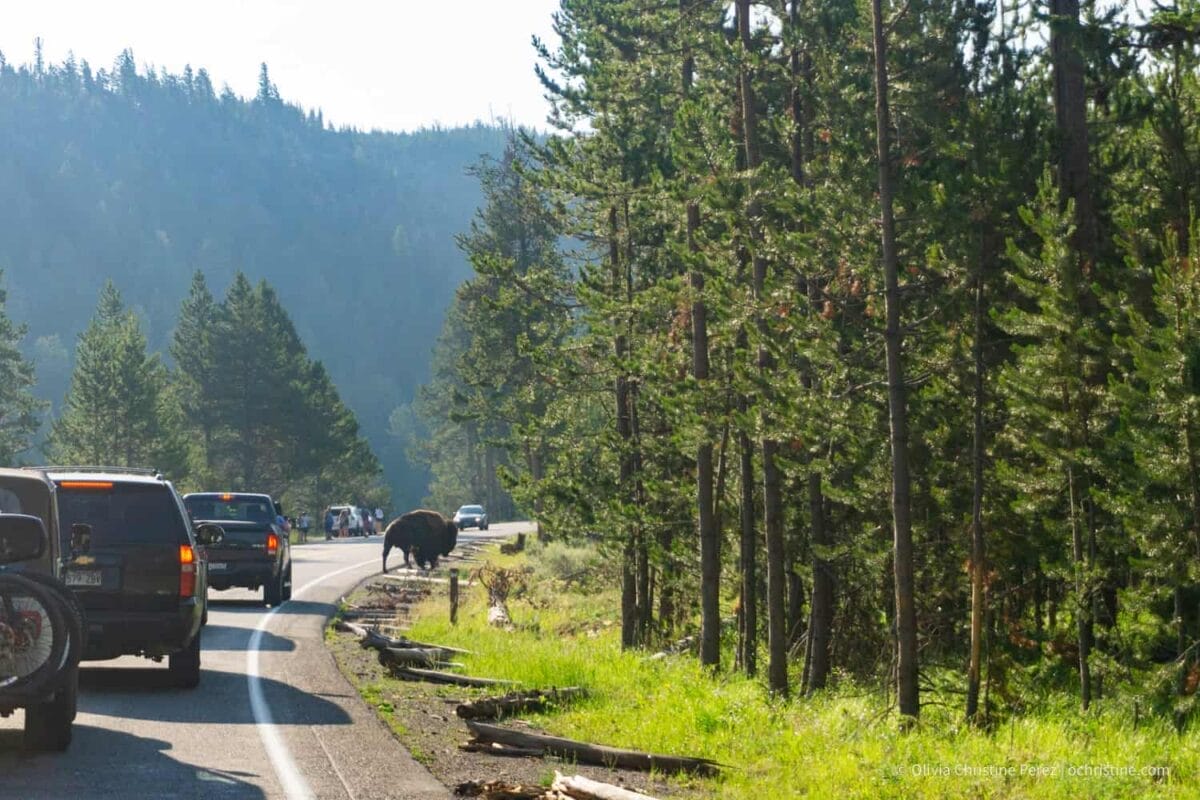

Where To Stay Near Yellowstone National Park
With over 2 million acres of park land, Yellowstone has so much to explore. Take your time to enjoy the sights by spending the night in or around the park.
Camping in Yellowstone National Park
There are 12 campgrounds within the park. Keep in mind that you have to book in advance and that spots fill quickly during peak season. It can be difficult to reserve a spot during these times, so it’s best to plan ahead and always check the site for updates on each campground’s status.
You must make a reservation as early as possible through Yellowstone National Park Lodges for the following campgrounds ($30-40 per night for tents):
- Madison Campground
- Grant Village Campground
- Fishing Bridge RV Park Campground
- Canyon Campground
- Bridge Bay Campground
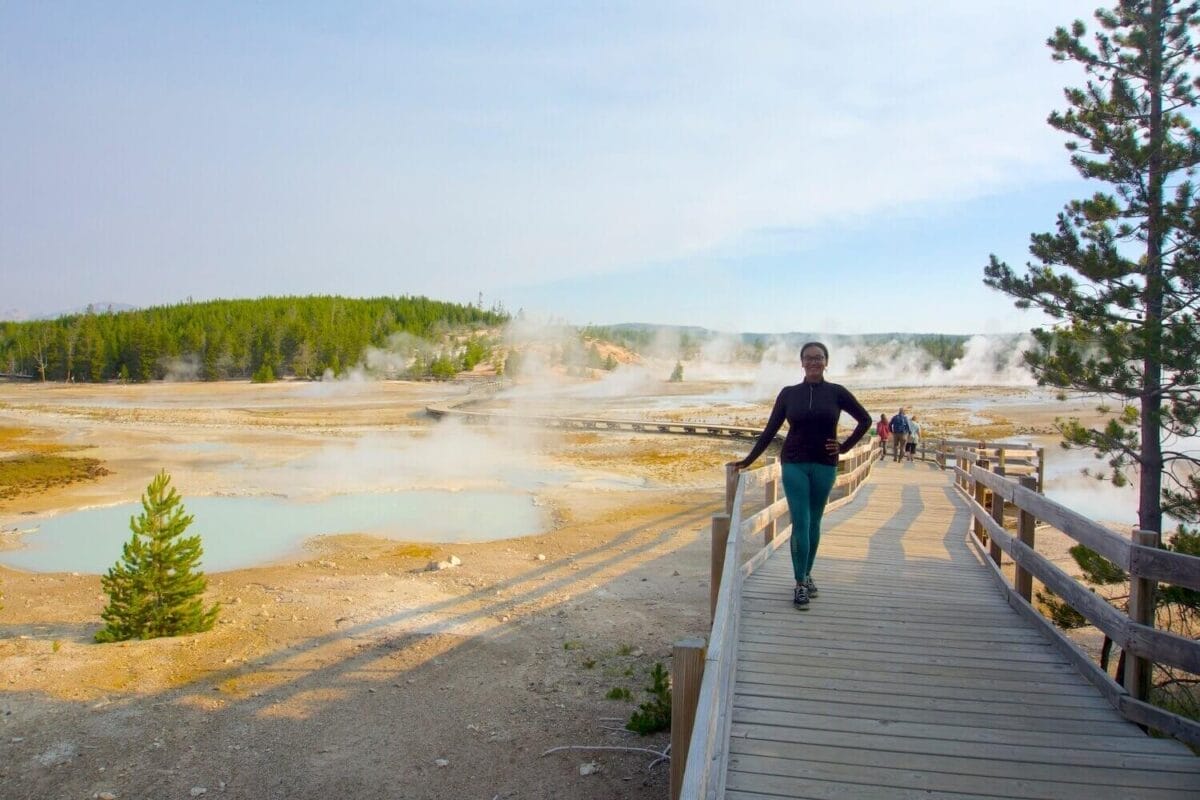

You can also find campgrounds via Recreation.gov, managed by the National Park Service (costs $20-25 per night for tents):
- Tower Fall Campground
- Slough Creek Campground
- Pebble Creek Campground
- Mammoth Campground
- Lewis Lake Campground
- Indian Creek Campground
Mammoth campground also offers some first-come, first-served spots from October 15th to April 1st. If you use the links provided above, you’ll see a chart displaying which campsites offer RV spaces ($99 per night), showers and bathrooms, etc.
Camping Outside of Yellowstone National Park
If you haven’t been able to secure a reservation at one of the park’s campsites, I recommend the KOA Holiday Campgrounds just outside of the park (10 minutes). This is where I stayed when I visited, because we booked so last minute.
For folks seeking RV spots or cabins near Yellowstone National Park, this KOA is a good option too. You can make this campground a home base with Deluxe Cabins and upgraded RV Sites for a comfortable glamping experience. As a lucky bonus for staying here, I saw a moose minutes from the campground on my way to dinner!
At the KOA you can expect to pay around $50/night for a tent site with no hook ups, or $100/night for a tent site with hook ups (like electricity, etc.)
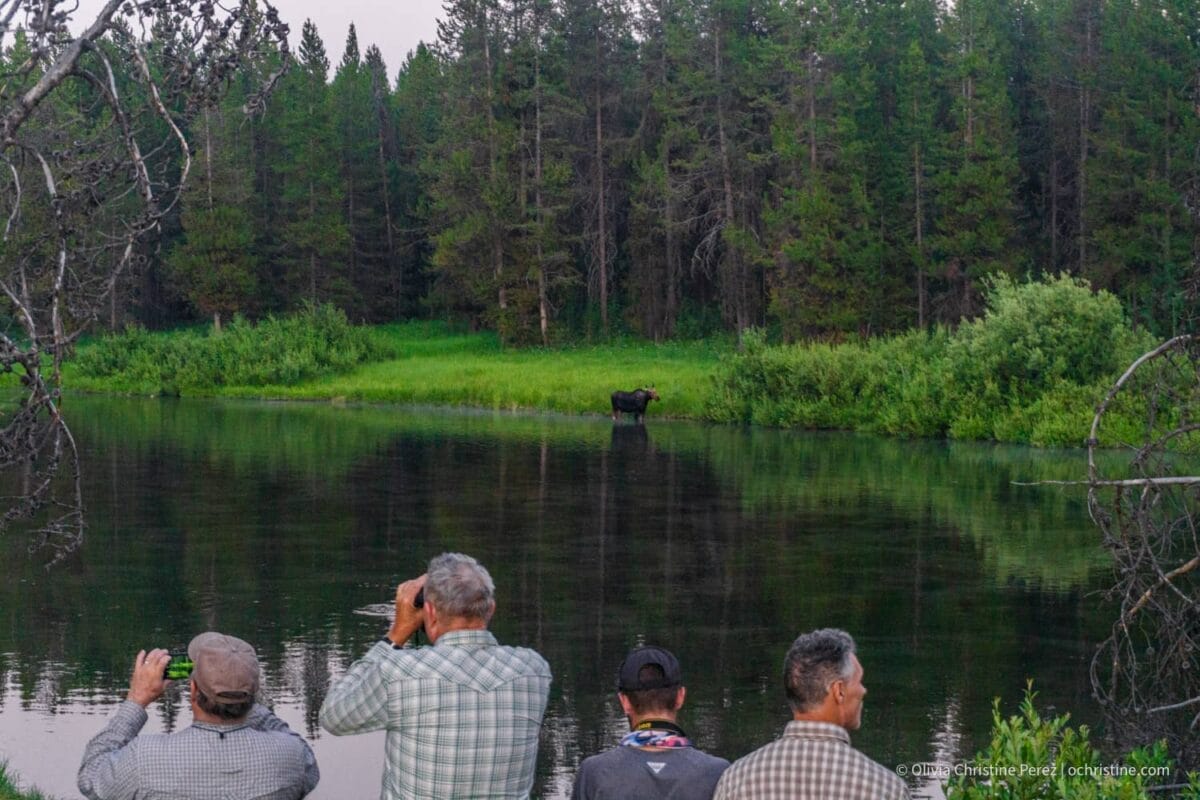

Bed Lodging Near Yellowstone National Park
If you’re looking for an alternative to camping, there are many hotels and lodges near Yellowstone.
- Yellowstone Riverside Cottages: These cottages are located in Gardiner, near the north entrance. They offer views of the Yellowstone river, air conditioning, free wifi and parking and more.
- Bar N Ranch: Located in West Yellowstone, Bar N Ranch offers a seasonal on-site restaurant, heated outdoor pool, free wifi, and gas or wood-burning fireplaces in each room. It also includes disc golf, cornhole, and horseshoe activities.
- The Pines at Island Park: A twenty minute drive away from Yellowstone National Park, this lodge has spacious holiday homes with BBQ facilities, fully-equipped kitchens, and satellite TV. It also has a restaurant that offers lunch and dinner.
My Yellowstone Itinerary
Here’s the breakdown of how we spent our days in Yellowstone.
If you need a bit more assistance with how to map out your days in Yellowstone National Park, consider using the 3 day Yellowstone itinerary I planned while there. To start, I took the free NPS map and divided it into four quadrants to break up the schedule.
Day 1 in Yellowstone
On day one I recommend getting Old Faithful Geyser out of the way. It is the most popular attraction in the park and thus, the most crowded. Since our first day landed on a weekday, it gave even more reason to take advantage of avoiding the weekend crowd. This area is in the Southwest quadrant of the park map.
We arrived the night before so woke up “early” (8 am) and entered through the West Entrance of the park with our annual pass. We first explored Old Faithful in the Upper Geyser Basin (you may have to sit around waiting for the next “eruption”, but the park will give an estimate). While we waited for the geyser to go off, we explored the along the boardwalk trails in the Upper Geyser Basin.
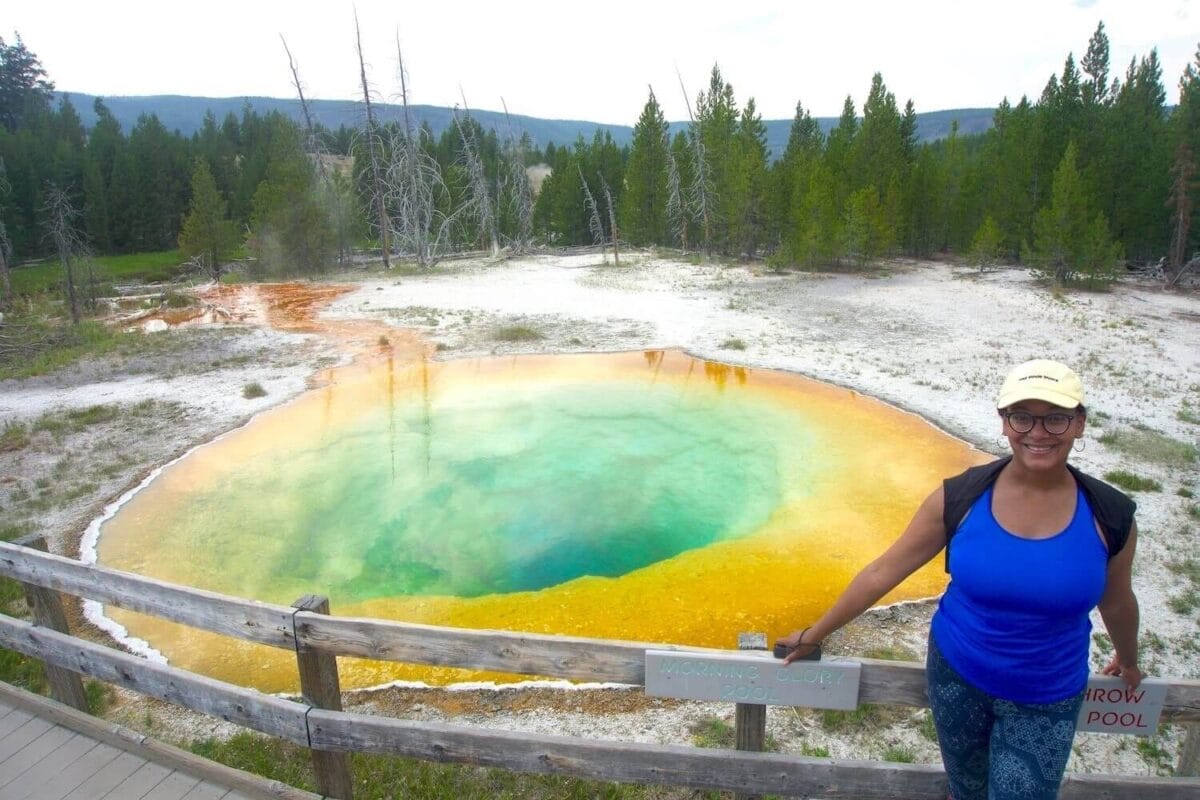

We also explored the Midway Geyser Basin where you can see the famous Grand Prismatic Spring. It is spectacular but the viewing platform gets crowded so it is hard to get a good photo above everyone’s head.
- Travel tip: anytime I mention exploring a basin, that should be regarded as a region of sorts. That means there are multiple pools and springs, and almost always paved boardwalk trails. I found the most popular sites within this park to be very accessible, with wide, flat boardwalks. I even saw people with motorized wheelchairs.


Day 2 in Yellowstone
On day two of this Yellowstone itinerary, we woke up earlier (6:30 am) and explored the northwest quadrant of the map toward Mammoth Hot Springs. Don’t get too excited – you can’t swim in these springs.
While during day 1 we saw a few bison, day 2 showed us a lot more wildlife! Herds of bison and elk were plentiful here, and we even saw a black bear while driving.


We drove farthest to Mammoth Hot Spring terraces first, and then turned around and drove back toward the West Entrance. This way we could see all the the sights on the way back.
The park is so big and there is lots of driving on this day, so we didn’t want to get stuck in the dark.
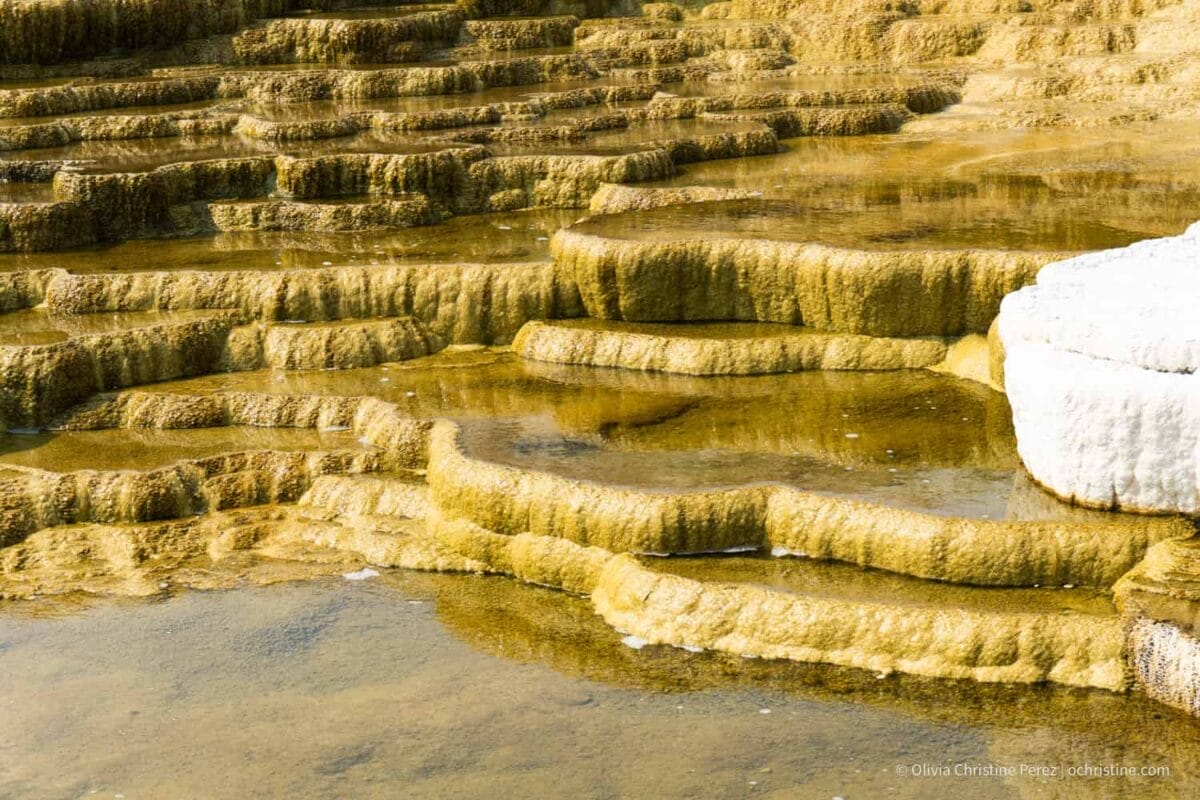

This route is good to for exploring Mammoth Hot Spring Terraces and the Albright village / visitor center (lots of Elk everywhere); viewing wildlife while driving along Lamar Valley; and walking the Norris Geyser Basin trails.
Additionally, if you plan concisely enough, you can make a detour to see Canyon Village east of Norris Geyser Basin.
The Northeast quadrant had some road construction so this allowed us to see some of that section since we didn’t have a fourth day. We saw beautiful waterfalls here and caught a bit of the sunset (I highly recommend Gibbon Falls, which has a lovely overlook).


Day 3 in Yellowstone
We were on an eastbound road trip so it made sense for us to leave the Southeast quadrant of the park for last, as it connected with the highway to continue on our journey.
On day 3 we woke up early again, packed our camp at the KOA, and drove toward Grant Village (which is past Old Faithful when coming from the west entrance).
Here you’d immediately stop to explore the West Thumb Geyser Basin, which also gives you a view of Yellowstone Lake! A cool, different sight. There were also people kayaking in the lake.




We then stopped at Lake Village to take photos of the Elk everywhere and stop at the general store.
Then we moved on to see Mud Volcano near Hayden Valley and drove on through the East entrance of the park to exit. While the lake and elk were cool, I’d say this quadrant was my least favorite of them all. There aren’t as many colorful springs in this section, and the mud pools were just… mud.
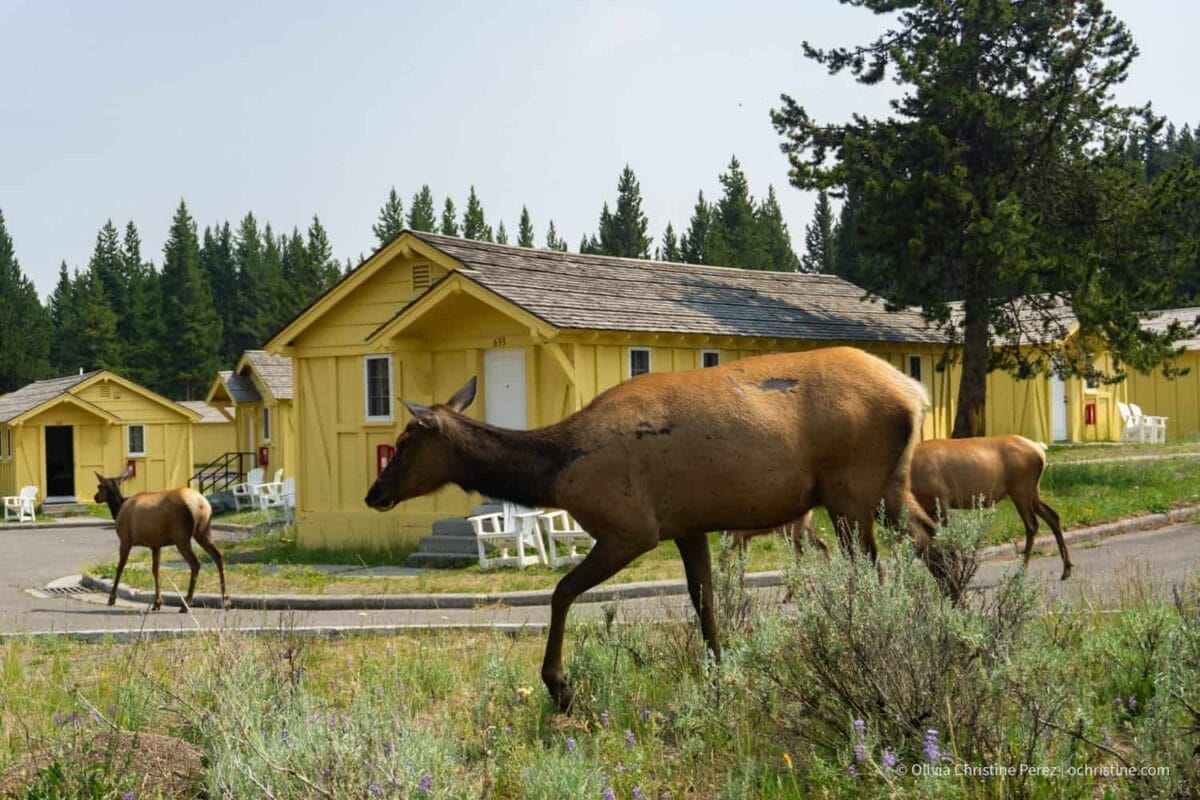

As you see from a lot of my photos, there is plenty of wildlife roaming free. There are also plenty of trails and viewpoints in close proximity to hot springs and geysers. While this is all very interesting, it can also be dangerous.
Between 2007-2023 there have been 74 deaths in Yellowstone. These vary from people falling in the boiling hot springs or from wildlife encounters with bison and bears, for instance.
Here are a few tips to remember for your safety:
- Photos:
- If you want photos of wildlife, bring a camera with good zoom. All of my photos were from far away and either zoomed in x3 on my iPhone or using my Sony kit lens, which only went up to 50mm (I didn’t even have my amazing 28-200mm camera lens yet, so I’d love to go back!)
- Wildlife:
- If you see a bison, moose, or elk, stay 25 yards away from it. That is the size of 2 school buses.
- If you see a bear or wolf, stay 100 yards away from it. That is the size of a football field.
- Hot Springs and Trails:
- When walking near hot springs and geysers, stay on the designated trail only. Many trails will have wide, slightly elevated boardwalks. Please stay toward the middle of the boardwalk so that if you trip or lose balance you will not fall off.
- If you have kids who run off, HOLD THEIR HANDS. Time and time again I see families in national parks and without fail there is a toddler who trips while running on a boardwalk.
- Do not crowd the trails. This increases the chance of someone getting bumped into or falling.
- Do not try to touch or swim in the water. It will burn. You might die.
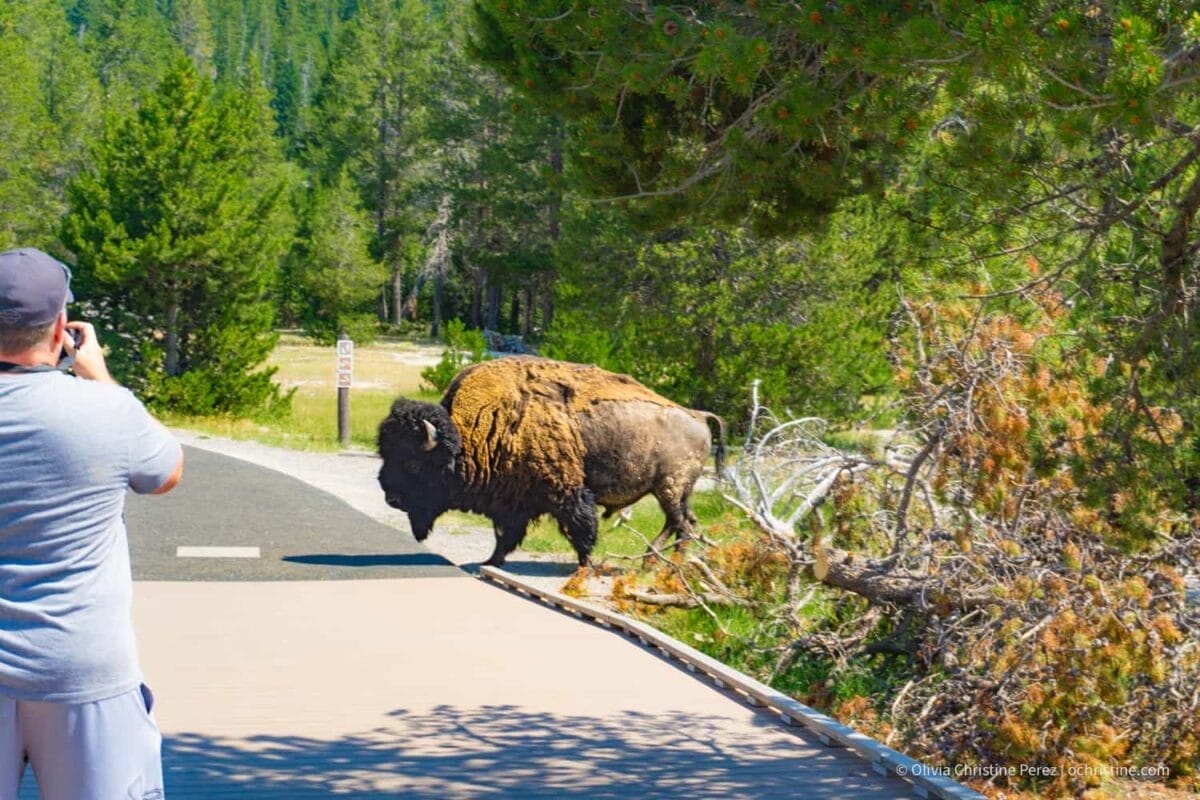

Have you been to Yellowstone National Park?
Yellowstone National Park is full of picturesque views and must-do activities, both for hikers and people just driving through. I hope you find use of this 3 day Yellowstone itinerary – I really enjoyed it and felt so empowered being able to take on such a behemoth of a park.
* * *
Hey Pinterest Fam!
Share this guide to 3 Day Yellowstone Itinerary by pinning the image below to your planning board.
